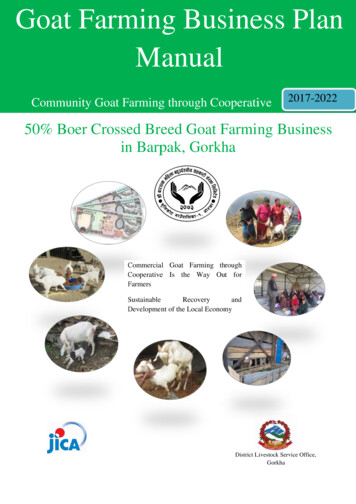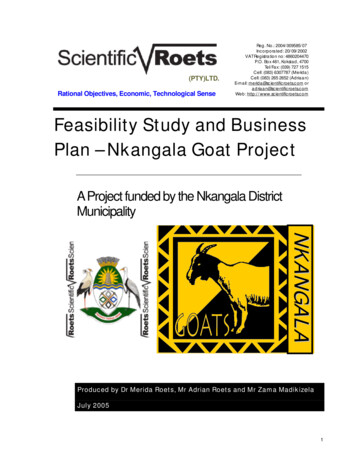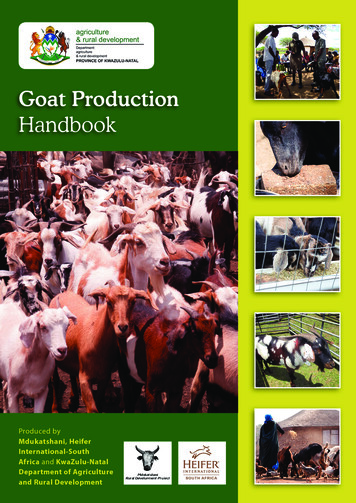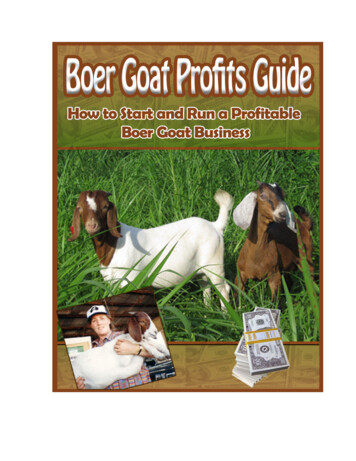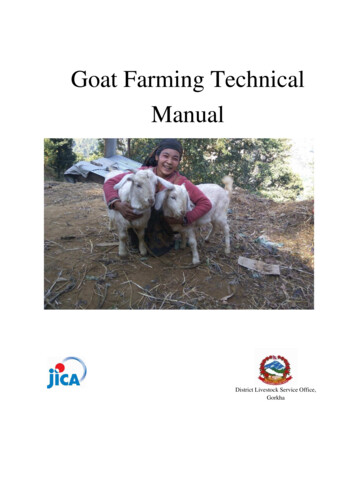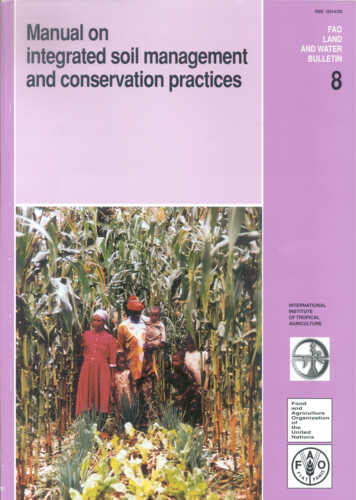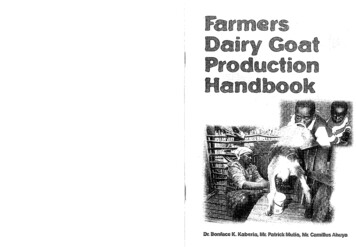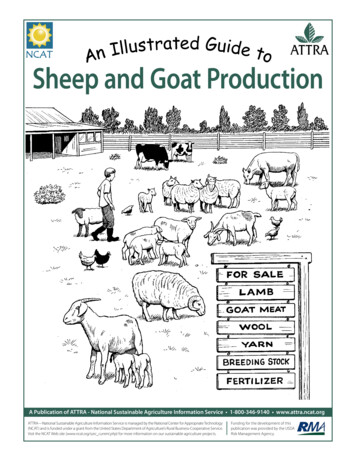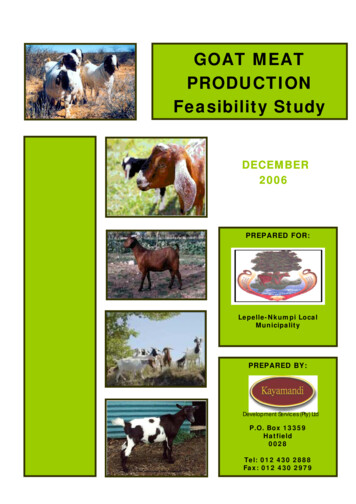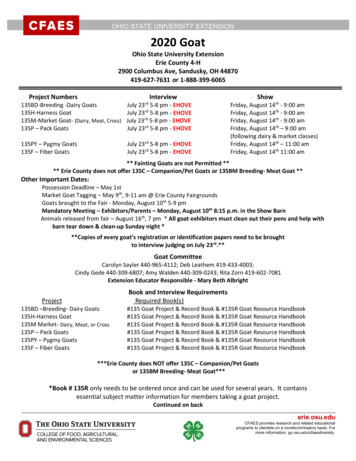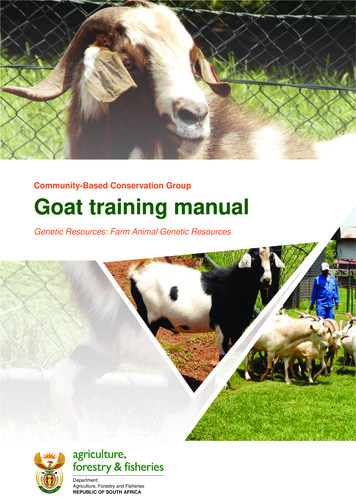
Transcription
Community-Based Conservation GroupGoat training manualGenetic Resources: Farm Animal Genetic ResourcesDJULFXOWXUH IRUHVWU\ ILVKHULHV&GRCTVOGPV#ITKEWNVWTG (QTGUVT[ CPF (KUJGTKGU4'27 . % 1( 5176* #(4 %#
Community-Based Conservation GroupGoat training manualGenetic Resources: Farm Animal Genetic ResourcesI
2016Printed and published byDepartment of Agriculture, Forestry and FisheriesEditing, Design and layout byDirectorate: Communication ServicesPrivate Bag X144, Pretoria 0001DISCLAIMERThe Directorate: Communication Services and its sub-directorates will not be held responsible for any documents that were broughtfor layout (Design and Publications Services Sub-directorate) without it having gone through for editing (Editorial Services Subdirectorate) this goes for all documents that are brought forward by the Directorate: Communication Services and it’s sub-directoratesfor thorough analysis of the content(s) thereof as this will compromise the quality of the work. Therefore, the authors or compilers ofthe original document(s) within the department are responsible for making sure that the proper channels and procedures are followedin ensuring that the document receives the required attention.II
Contents1.Conservation of Farm Animal Genetic Resources (FANGR) . 12.General management of goats. 23.Bibliography/Sourced used to develop the manual. 13III
IV
1.CONSERVATION OF FARM ANIMAL GENETIC RESOURCES (FANGR)Farm animal genetic resources refer to genetic materials from farm animals (e.g. cattle, sheep, goats and poultry, etc.) thatare used or maybe used for breeding purposes, for production of food and agriculture. These are materials that containfunctional unit of heredity which includes live animals, semen, oocytes, embryos, tissues, somatic cells and DNA. Thereason why indigenous farm animal genetic resources are important: They carry genes that enable them to adapt/tolerate harsh environments Can cope with thorny vegetation in drought-prone areas Can walk long distances, They are tolerant and/or resilient to diseases and parasitesHowever, over the years, high output producing exotic breeds have been given more attention than the local and adaptedbreeds. Due to climate change, the arid and semi-arid regions have been reported to be severely affected by drought andunder such conditions; indigenous animals have more competitive advantages over the exotic ones.1.1What is conservation of AnGR?It refers to action undertaken to ensure that the diversity of farm animal genetic material is being maintained for contributionto food production, agricultural production and productivity through planning, strategies and policies for future purposes.Effective conservation of genetic resources is possible only if the breeds are identified and documented adequately, andthere is a full participation towards conservation efforts of communities keeping the animals. There are basically two methods to conserve AnGR and they are in situ and ex situ conservation methods.The figure below summarises the two ways of conserving AnGRConservation methodsIn situNatural habitat/productionenvironmentEx situIn vivoLive animals e.g.in zoos, researchstation1.2In vitroCryopreservation ofsemen, oocytes,embyos, DNA, tissues,somatic cellsReasons for conserving FAnGRReasons for conserving FAnGR as indicated in literature, vary between situations, for example, agro-ecosystems, farmingsystem, species, breeds, as a result, reasons for conservation include, but are not limited to the following: To meet present socio-economic demand (FAnGR are a source of income for poor rural communities, losingthem will be detrimental to their livelihoods). Insurance against future changes in production circumstances. For cultural and historical reasons (Cultural and historical values of most communities are reflected by the typeof breeds they keep, therefore, conserving them is necessary to maintain their identity.) Opportunities to meet future demands. Regenerating population after disease outbreaks. Rescuing rare or endangered species or breeds. Providing a source of genetic material for research purposes. Supplying germplasm for the development of new breeds. Maintaining indigenous livestock gene pool diversity To fulfil the rights of an existing genetic resource to continue to exist.1
2.GENERAL MANAGEMENT OF GOATSThere are different types of goats in South Africa ranging from unimproved indigenous types to well-defined and established improved indigenous breeds types and the recognised exotic goat breeds. Goats in South Africa are foundin intensive, semi-intensive and extensive production systems, with large percentages of goats found in the extensiveproduction system, particularly in rural communities under communal production system. Below are some of the goatpictures for differentiation.Meat goat breedsIndigenous goats from Mara Research Station, Limpopo provinceBoer goatswww.boergoats.co.zaMilk breed: Saanen goatNationalsaanenbreeders.com2.1Savanna goatboerboksa.co.zaKalahari Red goatKalaharired.webmeester.co.zaMilk breed: Saanen goatNationalsaanenbreeders.comMohair breed: Angora goatwww.angoragoat.comHousingGoats require good housing that will protect them from harsh environmental conditions. The house should also provide adequate ventilation and hygiene, opportunity for better feeding and breeding.2
Types of goat housesGoat housing over erearthnews.comGoat housing over polewww.roysfarm.comwww.motherearthnews.com2.2 Nutrition and feedingGoats, like other animal species, require nutrients for body maintenance, growth and reproduction. The availability of forage does not always meet the nutrient requirements of the animals due to seasonal availability of feed resources, poormanagement, inappropriate grazing management, rangelands fires and droughts.Supplements provide nutrients that are deficient in natural veld or browse. Supplements can be in powder form, oftencalled licks, meal (such as HPC) or blocks. Ready mixed commercial supplements are available.Kids must receive colostrum soon after birth because the percentages of antibodies and nutrients found in colostrum decreases 48 hours after birth. Colostrum contains high content of energy, vitamins, minerals and antibodies that helps thekids to fight and resist infections/diseases.Note: Farmers/producers must consult with animal nutritionist all the time in order to purchase the correctsupplements. Animals must be introduced slowly to feed supplements and enough roughage must beprovided at all times.Use of body condition scoring to guide on nutrition Body condition score (BCS) is the reflection of good nutrition and hence adequate body tissue for normal functioning of the body.Table 1 Body condition scoringBCS1: Very thinBCS2: ThinBCS3: Moderately leanBCS4: Moderately fatBCS5: Very fatwww.articles.extension.org How to prevent loss of condition in animals during the dry season: Grass can be cut or leaves harvested and stored to give the goats during the winter months when feed isscarce. It must be dry when stored to prevent mould. Conserved feeds, usually hay are fed in winter Crop residues are grazed or processed for winter feeding. Feedstuffs such as maize stalks need to bechopped and adding molasses to them so that they are acceptable to goats.3
Winter fodder crops are established, which can be grazed during winter Other options to consider during drought Selling goats, particularly old and unproductive Early weaning Feedlotting2.3Animal identification and record keeping2.3.1 ANIMAL IDENTIFICATIONAccording to the Animal Identification Act (Act No. 6 of 2002) all livestock must be marked or identified. Each livestockowner must have their own identification mark with unique identification code. The code will be the one that the produceruses when tattooing. Tattooing is considered to be the safest and lawful way of identifying goats so far especially whenyour goats are lost or stolen and are found. A disadvantage about this method is that one can cut off the tattooed ears.Other methods of identifying animals such as ear tagging and ear notching can be used together with tattooing.2.3.1.1 TattooingHow to tattoo goats: Clean the inner part of the ear lobe thoroughly so that the ink can easily fill the holes made by the tattoo pliers. Apply or smear the tattoo ink on the area to be tattooed. Make sure that the sequence of the tattooing characters is correct according to the certificate of registration. Press the tattooing pliers until holes appear on the skin and then release. Rub the ink in to the holes. The excess ink can be cleaned and the characters should be easily readable as black dots in the ear.Tattooing toolsCleaning ear before tattooingApplying tattoo inkTattooingwww.premier1supplies.com2.3.2 RECORD KEEPINGRecord keeping helps to identify which animals should be kept as replacements for breeding purpose or should be keptin or culled from the breeding herd, in documenting pedigrees (relationships), in marketing animals for a premium price,to monitor the progress of the project (profit/losses) and generally helps in decision-making. Record keeping begins withindividual animal identification.4
Below are the examples of records:Examples of basic recordsKid recordKidIDsexDateofbirthHealth recordAnimalIDDateDoeIDBuckIDClinicalsignsDoe and buck recordDoe IDCull recordAnimal IDBirthtypeDiagnosisBirthweightDate ofweaningTreatmentplanDoe Date ofdeathAny observedcauses/symptoms ofdiseaseDate culledBreedWeaningweightDuration oftreatmentBuck IDAgeDateofdeathAny observedcauses/symptomsof diseaseDosage/Route ofadministrationBuck Date ofdeathSexAnimalrecovered(Yes or No)Any observedcauses/symptoms ofdiseaseReason for cullingMethod ofdisposalAnimal saleAnimal ID2.4BreedSexValue of goatSold priceDate of saleBuyerBreeding and selectionBreeding is the purposeful mating of male and female animals to improve certain characteristics in the progeny and it mustbe goal-driven. Breeding can be done by pure breeding or crossbreeding.Selection is the process whereby certain individuals are chosen for use as breeding animals for a certain period. Selectionis an important decision that a farmer takes, because the effect of selected animals remains in the herd or flock for manyyears. Animals are selected from the new kid crop for breeding purpose. Selection can be done through: Natural selection – adaptation and survival Artificial selection – by man Visual appraisal/appearance Pedigree recorded information Performance recorded information Combination of the above2.4.1 BREEDING OBJECTIVES AND SELECTION CRITERIABreeding objectives refers to decisions as to which traits the livestock keeper wants to improve, maintain or introduce intheir herds or flocks. The breeding objectives are achieved through selection criteria. The selection criteria refer to the traitsactually used in the selection of an animal.Table 2 Examples of breeding objectives and selection criteriaBreeding objectivesMilk productionMeat productionFertilitySelection criteriaMilk yieldUdder conformationBody capacityWeaning weightYearling weight18 month weightGrowth rateScrotalKidding intervalAge at first kidding5
2.4.2 SELECTION OF BREEDING BUCKBuck contributes more to genetic improvement in a herd as one buck can serve a number of females in a herd. Selection ofinferior breeding buck means increase in number of poor quality animals. Buck can be selected at weaning (3 to 4 monthsof age) using weaning weight, using post-weaning growth evaluation at 6 to 8 months of age. The buck should be replacedin the herd or flock every three years to prevent inbreeding and to make genetic improvements in the breeding stock. Thefollowing are examples of structural characteristics that can also be looked at when selecting a buck: Masculinity Standard buck/ram vocalisation Uniform pair of testes and a fine sheath Large scrotum circumference2.4.3 SELECTION OF BREEDING DOESelection of the replacement females is based on weaning weight and the development of the female (average daily gains).Further selection is done when the female is ready to breed. At this stage she must show signs of oestrus and becomepregnant at first mating. The final selection is made after the female has weaned its first kid. The following are examples ofstructural characteristics to be considered when selecting a doe: She must be feminine She must be fertile Good milk production Well structured udder with two functional teats Large body capacity and volume (associated with ability to breed, carry and rear kids and good milk production)Below are pictures of structural characteristicsBuck with excessive scrotal splitarticles.extension.orgBuck with firm mobile testicles in thescrotal sacwww.aces.edu/pubs/docsWell formed attached udder articles.extension.orgWell structured teatswww.jackmauldin.com.Buck with firm mobile testicles in thescrotal sacwww.aces.edu/pubs/docs2.4.4 SELECTION THROUGH PEDIGREE AND PERFORMANCE RECORDED INFORMATION For basic records refer to record keeping in 2.4.2.2.4.5 CULLING OF ANIMALSThis is the removal of animals from a breeding flock or herd. Organized data collection and record keeping (refer to 2.4.2)are required and individual animals must be identified. Animals can be culled due to several reasons. General reasons forculling include: Low production or reproduction levels6
Unproductive animals Genetic defects or pre-disposition to disease Physical problems Disease – decrease the amount of sub-clinical diseases and chronically ill animals Age – old, thin animals that no longer eat well2.4.6 BREEDING SEASONIn general, goat production in communal area is of free ranging goats. Mating occurs throughout the year. Kids are bornanytime. However; free ranging results in kids dropping throughout the year, makes management, recording and strategicfeeding of doe’s impossible or difficult and it also means that the farmer needs to keep the buck in good condition all yearround.2.4.7 CASTRATION OF MALE KIDSIt is the removal or destruction of the testes, epididymis and a portion of each spermatic cord from a buck. Castrationshould ideally be done at less than three weeks of age.The importance of castrating male kids: To maintain and control the breeding programme To successfully carry out breed improvement To improve on farm safety for animals and handlers because castrated buck is usually less aggressive and easierto manage. To lessen goat smell: meat from castrated male has less smell than tainted odour in the meat from intact bucks. For improvement of carcass composition and weight development.Note: It is important to let an experienced animal health practitioner show you how to do the castrations correctlybefore you do it yourself.Holding and controlling kid goats for castrationRestraining www.infovets.comRestraining and positioning thetesticles www.4h.ansci.cornell.eduMethods and tools that can be used to castrate male kidsElastrator methodRubber ringsElastrator7
Knife methodTouching the testiclesOpening the scrotum sacPushing out the testiclesCutting the cordSource: www.infovets.comBurdizzo/emasculator methodSource: www.infovets.com2.6General health management2.6.1 COMMON PROBLEMS OR DISEASESThere are a number of common problems and diseases that affect goats. Common problems and diseases are listed inTable 3 and 4 but are not limited to those listed in the tables. It means that this section does not cover all diseases andproblems affecting goats.Table 3 Common diseases affecting goatsCommon diseasesSymptomsPrevention/controlTreatmentHigh temperature and nervous signswhich include high stepping jerkyThis is a tickborne disease. Theorganisms that cause heartwater are gait, shivering, walking in circles.Later, jerky, paddling movementscalled Ehrlichia ruminantium. Thewith the legs and the head pulledorganisms are transmitted bybackwards when the animal goesBont ticks, which are mainly founddown. The dead animal’s post morin hot, dry bush areas. Heartwatertem will show excessive fluid in thecan result in death within 24 hours,heart sac, lungs, chest cavity andbut some cases survive two to fiveabdominal cavitydaysTo prevent heartwater, tryto maintain the animals’ immunityby letting a small number of ticksstay on the animals all the time.However, when there are visiblymany ticks on the goats, dippingabout once a month may be necessary. For vaccination, animal healthpractitioners must be consultedTreat the animal early beforenervous symptoms showPulpy kidney: (Enterotoxaemia)Effective vaccines are available.It is advisable to vaccinate beforedeworming animalsTreatment is always too late due tosudden appearance of symptomsand death. Focus on prevention(vaccination)Heartwater:This disease is caused by bacteriathat often exist within the animal’sintestine but only causes diseasesymptoms under certain circumstances such as a change ofgrazing, exhaustion, sudden dietarychanges and dosing with dewormers8Symptoms are sudden and may include exhaustion, paralysis and aloss of consciousness and mayhave laboured breathing, salivationand diarrhoea or have nervoussymptoms with convulsions,accompanied by salivation,grinding of teeth and muscletwitches until death.The carcass decomposes quicklyand post mortem shows haemorrhages on the heart and bloodunder the skin in the neck region,the lungs may contain excessiveamounts of blood and the heart sacmay contain fluid, the kidneys mayappear enlarged, dark red or palebrown and decomposed and maycontain large amounts of bloodUse oxytetracyclines products
Common diseasesSymptomsPrevention/controlTreatmentBlue tongue:Fever and/or high temperature,tongue and gum ulcers, blue tongueUse of midges repellent,Vaccination is available - consultanimal health practitionersAnimals with blue tongue diseaseare susceptible to pneumonia andthey must be treated. Useoxytetracyclines products only ifindicated Bluetongue is a Notifiableanimal disease and must bereported to either an animal healthtechnician or a state veterinarianFever, lack of appetite, difficultybreathing, coughing, loss ofcondition and discharge from thenose. The dead animal shows firmand/or red patchy lungsKeep pens or kraals clean Reductionof stress Vaccination for someagents is possible Consult withanimal health practitionersUse of an appropriate antibiotic ifrequired and anti-inflammatoryproducts. Ideally consult with animalhealth practitioners before treatingto help identify the causeThis disease is caused by a virusthat is transmitted by midges, whichare most found in warm and wetconditionsInfectious pneumonia:This disease is caused by bacteria/viruses and is likely to occur whenanimals are under stress and in dirtypens or kraalsMastitis:The udder is inflated, hard and hot to Hygiene is very important.Consult with animal healthIt is a bacterial infection of the udder. touch, producing either a brownishwatery fluid or watery milk containing practitionersThe udder can be infected throughpoor hygiene or injuries to the udder/ white or yellow clots or pusteatsUse an appropriate antibiotic.Consult with animal healthpractitioners to help identify thecause.By injection or throughintra-mammary directly into theudder via teatsCoccidiosis:Where there are outbreaks, treat allfemales and kids with remedy forcoccidiosis. Keep the animalshydrated. Consult with animal healthpractitioners. Can be treated withantibiotics or ionophoresThis disease mainly affects younganimals (kids). It is caused by anorganism known as coccidia. Olderanimals do become infected.However, due to developedimmunity, clinical signs do not show.Older animals are normally thesource of infection for the youngeranimals as they are carriers ofthe diseases. It attacks and destroysthe mucus of the intestine whichleads to animals having diarrhoeaand an inflamed intestinal liningShort period of diarrhoea and thenanimals quickly dying. Diarrhoea(may be bloody or contain mucusand be brown, yellow or greenish incolour), dehydration, anaemia, lackof appetite, loss of condition, rectalstraining (this may lead to prolapse),a rough hair coat. The post mortemof a dead animal may show tiny,greyish white spots in the mucousmembrane of the small intestine.Guts filled with fluid and bloodAvoid overcrowding, dirty and/or wetpens, kraals and unclean water andcontaminated feeds Coccidiostatssuch as Rumensin can be fed asindicated Consult with animal healthpractitionersNote: It is important to read the product label for dosage and instructions before administering any medication,wear protective clothing when handling animals (e.g. during treatment or vaccination) and disinfect equipments that are reusable. For prevention and treatment of diseases and conditions always consult animalhealth technicians and veterinarians.Controlled animal diseases in goats: Any disease that is not known to occur in South Africa (e.g. Peste de Pestis Ruminants, Contagious CaprinePleuropneumonia) Anthrax (zoonotic) Brucellosis (zoonotic) Foot and Mouth Disease Johne’s Disease Rabies (zoonotic) Rinderpest Tuberculosis (zoonotic) Bluetongue (notifiable, not controlled) Rift Valley Fever (notifiable, not controlled, zoonotic) If any of the above conditions are suspected or confirmed, it must be reported to the local Animal HealthTechnician or State Veterinarian.9
Table 4 Common problems and /or conditions affecting goatsCommon tion:Abnormal foetus or normal foetusdelivered preterm (dead)Enzootic abortion:Enzootic abortion:Vaccination is possible.Treatment is not practical and it iscost prohibitive.This is the result of a disturbance inthe functioning of afterbirth(placenta) or birth of the foetusbefore the expected normal kiddingtime. This can most frequentlybe caused by infections(e.g. enzootic abortion or Chlamydia,brucellosis) or non-infections (e.g.starvation or malnutrition)Scour or diarrhoea:This is a condition in which thedroppings of animals usuallybecome soft, watery and smelly.This condition can be a symptomof a disease. It can be caused byseveral factors which include butnot limited to the following:coccidiosis, colibacillosis, worms,poisonous plants or sudden changeof diet (high concentrates or lowroughage diet)Abscess:This is a swelling due toaccumulated pus inside the thickwall capsule. This is caused bybacteria entering the wound or injurycaused by ticks, grass seeds orthornsStarvation or malnutrition: adequatenutrition is important in avoidingunnecessary stress such astransporting heavily pregnant does.Genetic abnormalities, endocrinedisturbances or chronic infection:culling is recommendedBrucellosis:It is a controlled animal disease andmust be reported to either an animalhealth technician or a stateveterinarian. It may infect humansas well (zoonotic disease)NB: if possible, take the abortedfoetus and blood samples fromgoats to veterinary laboratory assoon as possible to identify theorganism causing abortion. Cleanyour hands properly afterhandling aborted foetus and wearprotective clothing all the timeThe droppings of animals usuallybecome soft, watery and smellywhich can be smooth and yellow,smooth and white, whitish with lumpsof thin skin in it, red or browndiarrhoea (which may indicate bloodin it)Worms:Hot, red swelling and painful totouch.Middle soft spot and falling hairwhen swelling is at the bursting pointTick control:Regular treatment will preventdiarrhoea caused by worms.Diet:Slow introduction of diet, avoidsudden changes, poor quality orexcessive concentrates.Coccidiosis can be treated orprevented with antibiotics orionophores.Ewes and does can be vaccinatedagainst colibacillosis to protect theirlambs/kids.Consult your animal healthpractitioner to help determine thecause of the diarrhoeaIf an animal is affected badly andgets affected more often, culling isrecommendedCorynebacterium may be vaccinatedfor. Note that this organism is verycontagious and may causeabscesses to spread(through equipment and facilities)within a herdIt is important to give sick animalssufficient water and electrolytes toprevent them from dying ofdehydration (a mix of one spoonsalt, 8 spoons sugar in one litre ofclean, luke-warm water).Coccidiosis can be treated withantibiotics or ionophores.Colibacillosis can be treated withantibiotics.Only when there is blood in thediarrhoea, may you consider youinject with a long acting anti-bioticor give a dose of terramycin powdermixed with water.Consult your animal healthpractitioner regarding treatmentCut, open and drain the abscesswhen it softens. Then syringe warm(boiled and cooled) water with alot of salt init (1 tablespoon of saltin a cup of water) or iodine into thewound. Spray daily with a woundaerosol. The wound must be keptopened and it must be flushed dailywith warm (boiled and cooled) saltwater to remove pus. Clean anddisinfect the syringe after each use.The goat can also be injected withan antibiotic if it shows other signs ofillness. Consult with your animalhealth practitionerNB: Bury or burn the materialused to wipe the pus to preventthe spread of infection to otheranimals and peopleOrf:This is a painful skin conditioncaused by a virus which only growsin the surface layers of the skin, butthe virus will only cause aninfection if the skin is alreadydamaged. This condition can affecthumans if they handle infectedanimals without protectingthemselves10Wart-like sores on the animal’s lipsand nose and, especially around themouth of kids and on the teats oftheir mothersAffected goats should bekept separate to prevent the spreadof the disease. Vaccination of alllambs and kids when the femaleshave stopped lambing for theseasonMost orf infections clear up on theirown. Lubricants such as petroleumoil and glycerine or paraffin oil canbe used to soften the hard scabs tomake it easier for the animals to eatand use of topical antibiotic paints,powders or aerosols can helpreduce the possibility of secondarybacterial infections
Common t:The animal’s stomach swells. Itbecomes uncomfortable and maylie down and cannot breathe andmay dieDo not allow animals to graze greenlucerne and clover or other plantsthat cause them to bloat Make surethat the lucerne is dried well andwithout mould before being given toanimals. Animals must be introducedvery slowly to wet pasturescontaining legumes and grains andmust be given large quantities ofhay. Beware of wire or plastic lyingaround where animals graze.Consult you animal healthpractitionerIf it is the blockage of oesophagusby feed, massage the neck, keep theanimal in standing position andagitate the ruminal contents mildly.It is the condition in which gasbecomes trapped in the rumen dueto interference of gas releasefollowing fermentation in the rumen(or occurs when rumen gasproduction is higher than the rate ofgas elimination). Bloat may occurwhen an animal grazes wet lushyoung pastures containing legumesor if grains (concentrates) areconsumed or due to blockage of theoesophagusDrench:Make the goat drink cooking oil(50 ml) or bloat guard. Be carefulthat the animal doesn’t choke – dosesmall amounts slowly. Do not let it liedown. If it is down, get it back on itsfeet and make it walk around until ithas belched. If the condition doesnot improve, pass a small diameterrubber tube down the throat(oesophagus) and into the stomachor In severe cases stab the bulgingarea with sharp pointed knife to letair escapeNote: It is important to read the label for dosage and instructions before administering any medication, wear protective clothing when handling animals (e,g. During treatment or vaccination) and disinfect reusable equipments. For prevention and treatment of diseases and conditions always consult animal health techniciansand veterinarians.2.6.2 INTERNAL PARASITESInternal parasites affect goats mostly in warm, moist climates. The most common internal parasites in goats are stomachworms/roundworms (Haemonchus contortus, commonly called barber pole worm); liver flukes (Fasciola hepatica) tapeworms, and intestinal parasites, the most common of which are coccidia (Eimeria or Isospora).Control and treatment of internal parasites: Use of Famacha chartThe FAMACHA chart system can be used very effectively to select individual animals for treatment of haemonchosis. It isbased on assessing the level of anaemia.Source: www.sheepandgoat.com Use of five-point check systemIt is for targeted selective treatment of internal parasites and for expanding the utility of the FAMACHA system.11
Source: www.sheepandgoat.com Use of worm remedies There are several remedies available for treatment of internal parasites. It is advisable to use worm remedies that treat more than one type of internal parasites to save money. Animal health technicians and veterinarians must be consulted all the time. Good management Keep your animals in good condition by giving them good quality feeds. Genetic selection of goats that are resistant or resilient to internal parasites is very important. Animals that are persistently affected by parasites should be culled. Contaminated feeds should be avoided and good goats housing can prevent that. Avoid grazing/pasturing in damp areas and during early morning and evening hours, when there is dew on thepasture.2.6.3 EXTERNAL PARASITESThe warm and/or hot, moist climates favour the propagation of external parasites that affect goats. The most commonexternal parasites affecting goats are ticks and mange. Other external parasites include fleas, lice and nasal bot. For contr
Farm animal genetic resources refer to genetic materials from farm animals (e.g. cattle, sheep, goats and poultry, etc.) that are used or maybe used for breeding purposes, for production
